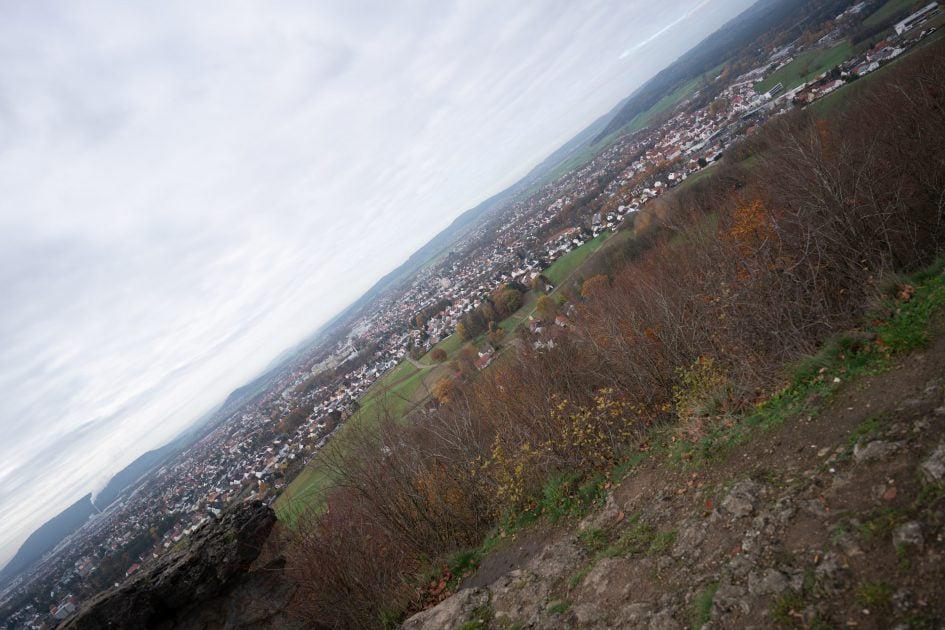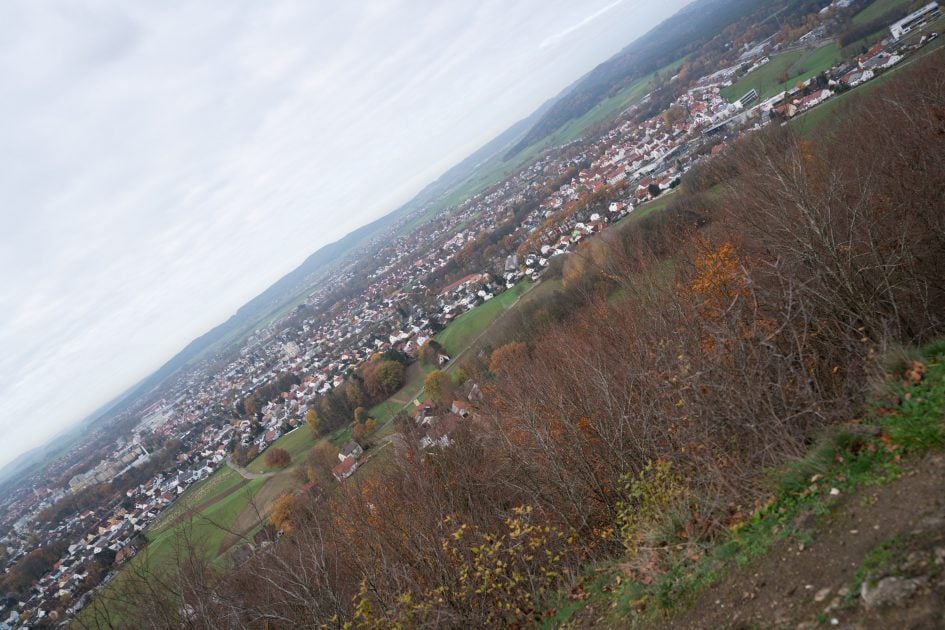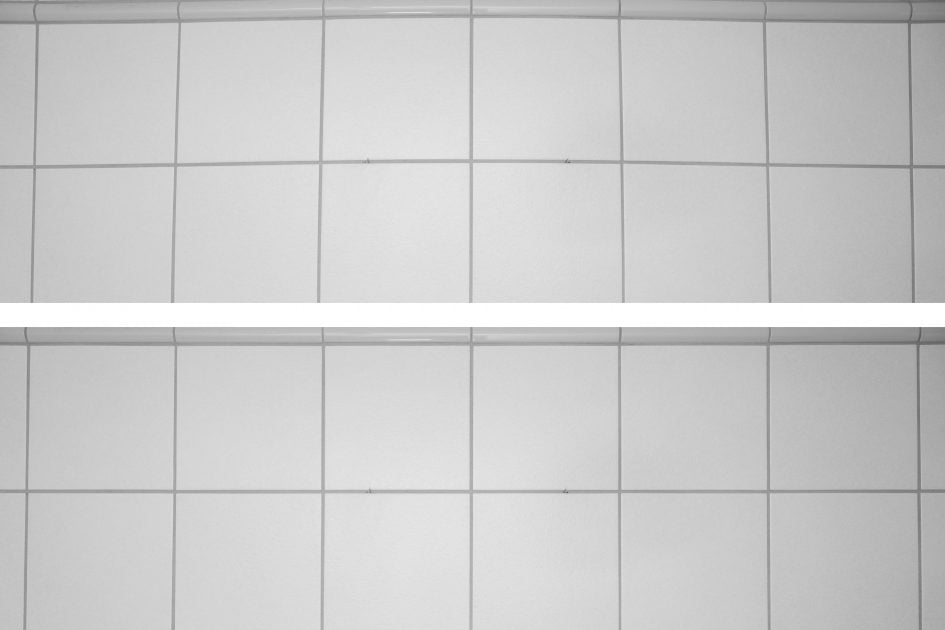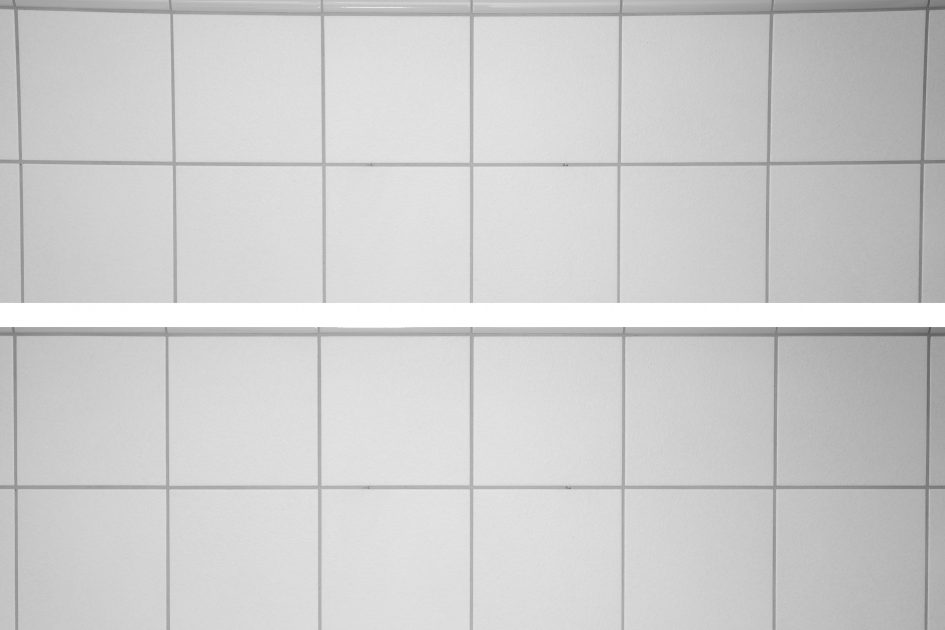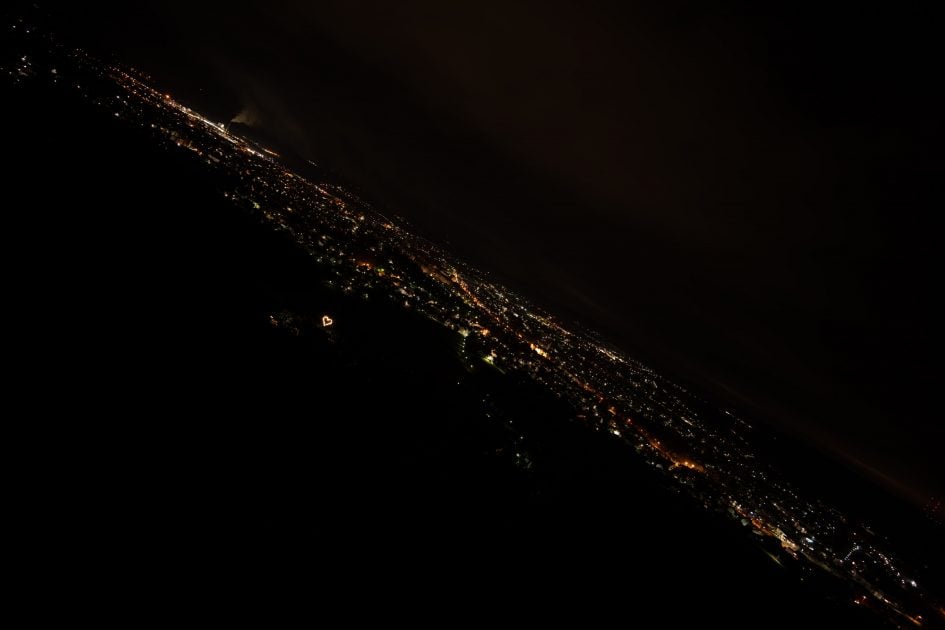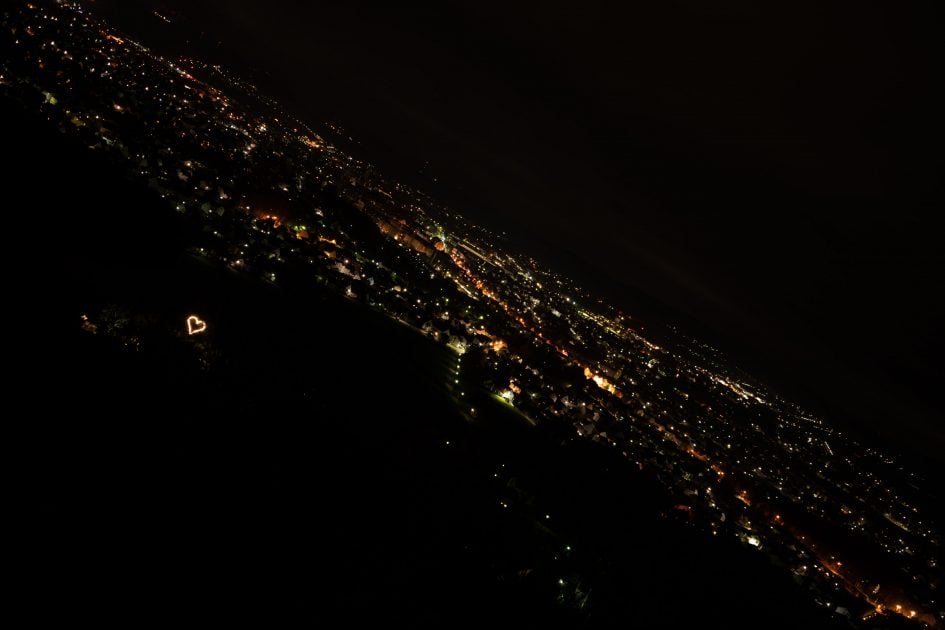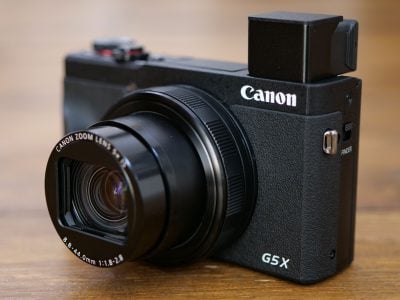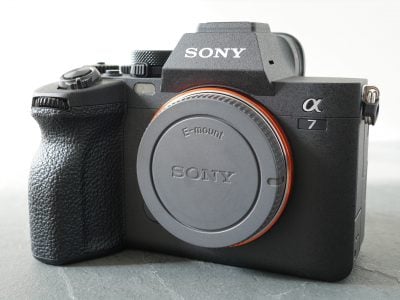Tamron 20-40mm f2.8 Di III review
-
-
Written by Thomas
Quality
Longitudinal Chromatic Aberration and focus shift
Lenses with focal ratios of f2.8 or larger are often prone to longitudinal color aberrations (loCA, a.k.a. “axial color” or “bokeh CA”). These show up as magenta coloration in the foreground and greenish hues in the background and are not easily corrected in post-processing. The new Tamron is very good in this respect: there is almost no loCA to be seen at f2.8.
Tamron 20-40mm f2.8 Di III Longitudinal Chromatic Aberration (loCA) at 28mm
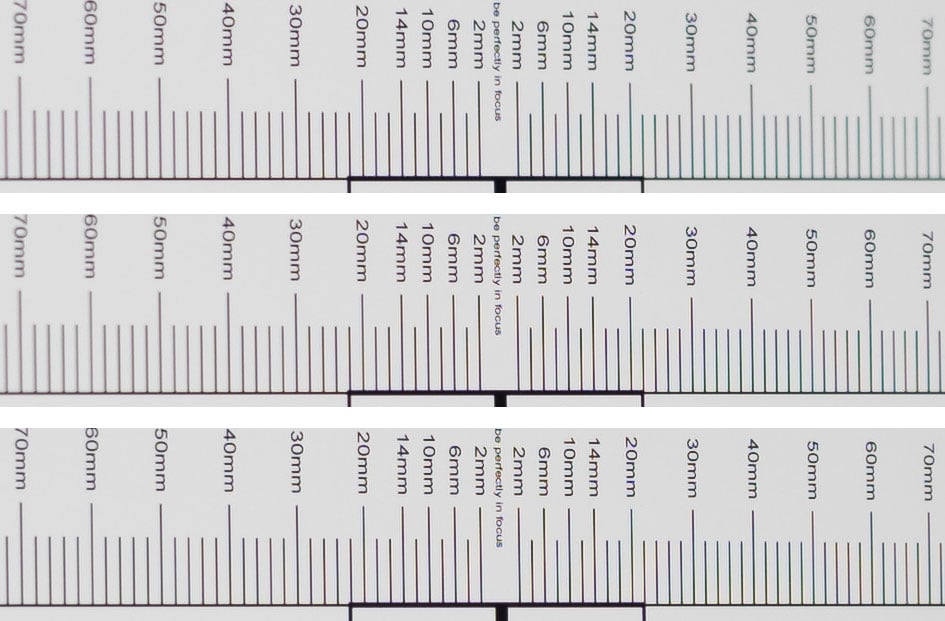
100% crops at 40mm f2.8 (top), f4.0 (bottom); 100% crops, left = foreground, right = background
There is also only a little focus shift away from the camera when stopping down from f2.8 to f4.0: See how the 40mm mark on the left gets less sharp when the lens is stopped down to f4.0.
The following shot shows that the Tamron 20-40mm f2.8 Di III produces only a bit of green and magenta outlining around out-of-focus subjects:

Above: Tamron 20-40mm f2.8 Di III at 40mm f2.8, 100% crop; click here for large original
Sharpness and contrast
Let’s have a look at the theoretical performance of the Tamron 20-40mm f2.8 Di III first and compare it to the performance of the Tamron 17-28mm f2.8 Di III and Sony FE 16-35mm f2.8 GM:

Above: MTF Tamron 20-40mm f2.8 Di III at 20mm, f2.8 (left) and 40mm, f2.8 (right)

Above: MTF Tamron 17-28mm f2.8 Di III at 17mm, f2.8 (left) and 28mm, f2.8 (right)
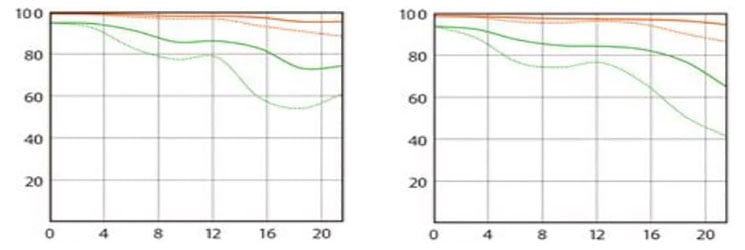
Above: MTF Sony FE 16-35mm f2.8 GM at 16mm, f2.8 (left) and 35mm, f2.8 (right)
These MTF charts show the computed lens-performance of lenses wide open at infinity without influence of diffraction at 10 line-pairs/mm (red) and 30 lp/mm (gray/green). Higher values are better (more contrast) and the closer the dotted and solid lines are together the less contrast dependents on the orientation of the test-pattern (less astigmatism). The x-axis displays the distance from the optical axis (=center of the sensor) in mm.
Overall contrast at 10 lp/mm (red lines) should be very good with all three lenses. But looking at the contrast of finer details reveals some differences. Both Tamron lenses show a clear drop in contrast/resolution outside the APS-C image-circle while the Sony holds on much better. And all lenses show quite some astigmatism except for the Tamron 17-28mm at the long end. From the charts the Tamron 20-40mm f2.8 Di III should be pretty sharp at the short end within the APS-C image-circle.
Let’s see how this theoretical performance translates into real-life results in the sharpness test based on Siemens-stars at 4 mm (“center”), 13 mm (APS-C-corner), and 20 mm (FF-corner) off axis. Processing was done in Lightroom 12.0.1/CRAW 15.0 from RAW to Adobe Color profile with the built-in lens profile for CA compensation applied (but no distortion compensation). Noise-reduction is set to 0, sharpening to 50/0.5/36/10, with no extra tone, color, or saturation adjustment. White-balance was adjusted to a neutral white and I did some exposure compensation to make the brightness of all crops match. So you will not see light fall-off in the corners.
The following are all 100% crops!
First up is an overview of the wide-open performance at different focal lengths. You can jump to the detailed results at different apertures and comparisons with the other lenses by clicking on the crops of the respective focal length.
Tamron 20-40mm f2.8 Di III; 100% crop from center, APS-C-corner, FF-corner

Above: 20mm, f2.8

Above: 25mm, f2.8

Above: 30mm, f2.8

Above: 40mm, f2.8
From the overview the new Tamron delivers very good sharpness at 20mm focal length within the APS-C image-circle and very usable results in the FF-corner. Zooming in softens the results visibly, especially in the FF-corner. The APS-C-corner also loses its crispness but stays still good. The center softens only slightly at 30mm and a bit more at 40mm focal length. This performance is good to very good over the zoom range in the APS-C image-circle but the extreme full-frame corners are clearly not the forte of this lens.
If you want to see all the details and comparisons with the Tamron 17-28mm f2.8 Di III and Sony FE 16-35mm f2.8 GM, read on. Or you can fast-forward to the performance at long distances.
Performance at 20mm:
Tamron 20-40mm f2.8 Di III at 20mm compared; 100% crop from center, APS-C-corner, FF-corner

Above: Tamron 20-40mm f2.8 Di III at 20mm, f2.8

Above: Tamron 17-28mm f2.8 Di III at 20mm, f2.8

Above: Sony FE 16-35mm f2.8 GM at 20mm, f2.8

Above: Tamron 20-40mm f2.8 Di III at 20mm, f4.0

Above: Tamron 20-40mm f2.8 Di III at 20mm, f5.6

Above: Tamron 20-40mm f2.8 Di III at 20mm, f8.0; also available at f11
At 20mm the Tamron 20-40 is sharper than the Tamron 17-28 and even a little bit better than the Sony GM – except for the FF-corner. Stopping the Tamron 20-40 down to f4.0 or f5.6 visibly lifts corner performance.
Performance at 25mm:
Tamron 20-40mm f2.8 Di III at 25mm compared; 100% crop from center, APS-C-corner, FF-corner

Above: Tamron 20-40mm f2.8 Di III at 25mm, f2.8

Above: Tamron 17-28mm f2.8 Di III at 24mm, f2.8

Above: Sony FE 16-35mm f2.8 GM at 24mm, f2.8

Above: Tamron 20-40mm f2.8 Di III at 25mm, f4.0

Above: Tamron 20-40mm f2.8 Di III at 25mm, f5.6

Above: Tamron 20-40mm f2.8 Di III at 25mm, f8.0; also available at f11
At 25mm both Tamron lenses look very similar while the Sony GM clearly leads outside the center. The FF-corner of the Tamron 20-40 needs stopping down to f8.0 to become well-defined.
Performance at 30mm:
Tamron 20-40mm f2.8 Di III at 30mm compared; 100% crop from center, APS-C-corner, FF-corner

Above: Tamron 20-40mm f2.8 Di III at 30mm, f2.8

Above: Tamron 17-28mm f2.8 Di III at 28mm, f2.8

Above: Sony FE 16-35mm f2.8 GM at 28mm, f2.8

Above: Tamron 20-40mm f2.8 Di III at 30mm, f4.0

Above: Tamron 20-40mm f2.8 Di III at 30mm, f5.6

Above: Tamron 20-40mm f2.8 Di III at 30mm, f8.0; also available at f11
At 30/28mm the Sony GM is the best, followed closely by the Tamron 17-28 and Tamron 20-40 which has the slightly sharper center than its shorter sibling but the softer APS-C-corner. But overall, the differences are small. Again, stop the Tamron 20-40 down to f8.0 to get well-defined FF-corners.
Performance at 40mm:
Tamron 20-40mm f2.8 Di III at 40mm compared; 100% crop from center, APS-C-corner, FF-corner

Above: Tamron 20-40mm f2.8 Di III at 40mm, f2.8

Above: Sony FE 16-35mm f2.8 GM at 35mm, f2.8

Above: Tamron 20-40mm f2.8 Di III at 40mm, f4.0

Above: Tamron 20-40mm f2.8 Di III at 40mm, f5.6

Above: Tamron 20-40mm f2.8 Di III at 40mm, f8.0; also available at f11
At 40mm focal length the Tamron 20-40 has only the Sony GM (at 35mm) to compare to. Wide open the Sony GM is clearly sharper which bodes well should the need arise to crop images from the Sony GM to the angle-of-view of 40mm focal length. But stop the Tamron 20-40 down to f4.0 and it matches Sony’s performance (at f2.8).
All-in-all the Tamron 20-40mm f2.8 Di III (and the Tamron 17-28mm f2.8 Di III) performs pretty close to the Sony FE 16-35mm f2.8 GM at 20mm even surpassing it in the APS-C image-circle. Stopping down the Tamron 20-40 to f4.0 makes it match the sharpness of the Sony GM (at f2.8). But if you shoot architecture or landscapes and need well-defined FF-corners stop down further to f5.6 or even f8.0.
Performance at long distances
The Siemens-star test-targets are shot at a distance of 45x focal length (i.e., at around 1.8m for 40mm focal length). But performance of lenses also depends on the shooting distance. Therefore, I present another series of images shot on a 42MP Sony A7R II of a city around 1 km away. Processing was done in Lightroom 12.0.1/CRAW 15.0 from RAW to Adobe Color profile with Adobe’s lens profile compensating distortions but not vignetting. Noise-reduction is set to 0, sharpening to 50/0.5/36/10, with no extra tone, color, or saturation adjustment. All shots were made from a heavy tripod with image stabilization switched off. As usual I have selected the diagonal that provided the better corner results.
The following images show the complete scene wide open plus 100% crops from the center, APS-C-corner, and FF-corner shot with the Tamron 20-40mm f2.8 Di III. You can access the large originals but please respect our copyright and only use those images for personal use.
Tamron 20-40mm f2.8 Di III at 20mm
Above: Tamron 20-40mm f2.8 Di III at 20mm, f2.8; click image for 4k version, here for large original; crops also available at f4.0, f5.6, f8.0, f11
Tamron 20-40mm f2.8 Di III at 30mm
Above: Tamron 20-40mm f2.8 Di III at 30mm, f2.8; click image for 4k version, here for large original; crops also available at f4.0, f5.6, f8.0, f11
Tamron 20-40mm f2.8 Di III at 40mm
Above: Tamron 20-40mm f2.8 Di III at 40mm, f2.8; click image for 4k version, here for large original; crops also available at f4.0, f5.6, f8.0, f11
From the test-shots above it is clear that the far corners are a weakness of the Tamron 20-40mm f2.8 Di III even at long-distance shots: Stop down to f8.0 if you need well-defined FF-corners. The Tamron 17-28mm f2.8 Di III is clearly better in this respect. The APS-C image-circle looks better – even very good at 20mm. At longer focal lengths the center stays very sharp but the APS-C-corners start to profit from stopping down to f4.0 or even further.
Vignetting and distortions
To make it easier to see light fall-off in the corners of a full-frame sensor I’ve arranged a series of three shots each with the Tamron 20-40mm f2.8 Di III at 20mm and 40mm focal length, different apertures, and focused to infinity. The following images were shot as RAW-files and developed to the same brightness in the center.

Above: Tamron 20-40mm f2.8 Di III at 20mm; shading compensation in camera set to Off (top), Auto (bottom)
The sample images above show that with shading compensation on Auto the extreme corners are lifted about 0.9 EV at f2.8. Still vignetting can clearly be seen. Adobe’s RAW converter automatically applies shading compensation as it was set in camera – but you cannot alter the setting in postprocessing. Btw: If you have shading compensation on Auto and apply the lens profile supplied by Adobe you might be overcompensating. In this case reduce the amount of vignetting correction from Adobe’s lens profile.

Above: Tamron 20-40mm f2.8 Di III at 40mm; shading compensation in camera set to Off (top), Auto (bottom)
At 40mm shading compensation on Auto lifts the extreme corners by about 0.6 EV at f2.8. This makes vignetting pretty inconspicuous.
Regarding distortions: Adobe’s RAW converter ignores what was set in camera and does not correct for them. You need to apply Adobe’s lens profile to get rid of them. Just don’t forget to dial vignetting compensation back. The lens has some barrel-distortions at the short end with a clear mustachio effect at a shooting distance of around 1m.
Distortions: Tamron 20-40mm f2.8 Di III at 20mm; distortion correction from Adobe lens profile Off (top), 100% (bottom)
Distortions at 40mm focal length are of pincushion type.
Distortions: Tamron 20-40mm f2.8 Di III at 40mm; distortion correction from Adobe lens profile Off (top), 100% (bottom)
Distortion correction through Adobe’s lens profile works quite well.
Rendering of point-light sources at night-shots
Night-shots pose a different challenge for lenses as the contrast is even higher than under bright sun and point-light sources can reveal some weaknesses such as coma, haloing and colour-aberrations that do not show up as prominently in other test-shots. The 100% crops below the main image show the effect of coma in the FF-corner of the Tamron 20-40mm f2.8 Di III at different apertures:
Above: Tamron 20-40mm f2.8 Di III at 20mm, f2.8; click image for 4k version, here for large original

Above: Tamron 20-40mm f2.8 Di III at 20mm; 100% crops from the FF-corner at f2.8 (left), f4.0 (middle), f5.6 (right)
Above: Tamron 20-40mm f2.8 Di III at 40mm, f2.8; click image for 4k version, here for large original

Above: Tamron 20-40mm f2.8 Di III at 40mm; 100% crops from the FF-corner at f2.8 (left), f4.0 (middle), f5.6 (right)
At 20mm focal length the Tamron 20-40mm f2.8 Di III produces very little coma even wide open. At 40mm a bit of coma can be seen. The test also shows no color artifacts around bright streetlights at any focal length.
Bokeh quality
This test is for the rendering of point-light sources in an out-of-focus background. The circle of confusion that is produced by the test is pretty indicative of Bokeh performance (in the background) and light fall-off. Ideally the out-of-focus image of the point-light is evenly lit and perfectly circular, with no “onion-rings”, and without coloration. Large aperture lenses normally produce an effect known as “cat’s eye” the further away from the optical axis the point-light is projected. This is due to optical vignetting in the lens barrel when light enters the lens from an angle.
The crops below the main image are from the center, APS-C-corner, and FF-corner of the 4k version.
Above: Tamron 20-40mm f2.8 Di III at 40mm, f2.8; click image for 4k version
Above: Tamron 20-40mm f2.8 Di III at 40mm, f2.8; click image for 100% crop
Above: Tamron 20-40mm f2.8 Di III at 40mm, f4.0; click image for 100% crop
Above: Tamron 20-40mm f2.8 Di III at 40mm, f5.6; click image for 100% crop
The diameter of the Bokeh balls in the center is determined by the entrance pupil of the lens. This is only 14mm for the new Tamron at 40mm focal length which is not much. But compression of the circle towards the corners is relatively mild wide open. The circle of confusion in the center stays pretty well-rounded even stopped down to f8.0. The inside of the Bokeh balls shows some onion rings and outlining – albeit without coloration from loCA.
Let’s see how this analysis of out-of-focus point-light sources translates into Bokeh-performance shooting a bookshelf. Crops are from the foreground, middle-ground, and background resized to make them comparable across all my reviews.
Above: Tamron 20-40mm f2.8 Di III at 40mm, f2.8; click image for 4k version, here for large original
Above: Tamron 20-40mm f2.8 Di III at 40mm, f2.8; click image for 4k version, here for large original
Above: Tamron 17-28mm f2.8 Di III at 28mm, f2.8; click image for 4k version, here for large original
Above: Sony FE 16-35mm f2.8 GM at 35mm, f2.8; click image for 4k version, here for large original
Clearly the 20-40mm f2.8 Di III produces the softest Bokeh of the three lenses compared here. And double contours are hardly a problem as can be seen in another crop (now at 100%) from the same images showing the ruler:
Above: Tamron 20-40mm f2.8 Di III at 40mm, f2.8, 100% crop; click image for 4k version, here for large original
Above: Tamron 17-28mm f2.8 Di III at 28mm, f2.8, 100% crop; click image for 4k version, here for large original
Above: Sony FE 16-35mm f2.8 GM at 35mm, f2.8, 100% crop; click image for 4k version, here for large original
Close-up performance
The Tamron 20-40mm f2.8 Di III achieves a pretty decent maximum magnification of 1:4.4 in close-up shooting at 40mm focal length where the area of sharp focus is just 106 x 158mm. The shots shown below are at 1:4.6 magnification with crops from 0mm, 14mm, and 19mm off the center of the sensor respectively.
Tamron 20-40mm f2.8 Di III at 40mm, 1:4.6 magnification; 100% crops

Above: Tamron 20-40mm f2.8 Di III at 40mm, f2.8

Above: Tamron 20-40mm f2.8 Di III at 40mm, f5.6

Above: Tamron 20-40mm f2.8 Di III at 40mm, f11
At 40mm focal length the Tamron 20-40mm f2.8 Di III produces very soft results wide open, and you better stop down to f5.6 to get good sharpness in the center. But the APS-C-corner stays soft until the lens is stopped down to f11. This is only partly due to field curvature.
The next images shown below were shot at 20mm focal length and 1:4.8 magnification with crops from 0mm, 12mm, and 18mm off the center of the sensor respectively. At the short end the Tamron 20-40mm f2.8 Di III produces sharper results than at 40mm, but you still better stop down to f5.6 to get sharpness to usable levels outside the center. And don’t forget to take the lens hood off – otherwise you risk blocking the light from your subject.
Tamron 20-40mm f2.8 Di III at 20mm, 1:4.8 magnification; 100% crops

Above: Tamron 20-40mm f2.8 Di III at 20mm, f2.8

Above: Tamron 20-40mm f2.8 Di III at 20mm, f5.6

Above: Tamron 20-40mm f2.8 Di III at 20mm, f11
Flare, ghosting, and sunstars
Catching a strong light-source shining directly into the lens is always a risky business: it could produce strange colorful ghost-images or reduce contrast considerably through flare and glare. The appearance of flare and ghosting depends on factors like the aperture and the angle of the light hitting the lens. So, to judge the proclivity of Tamron’s 20-40mm f2.8 Di III for these artifacts I went through a series of well calculated shots against a strong light source to provoke glare and ghosting. The lens hood was mounted in all shots. Following are two of the more extreme example results. The little bright square inset in the upper left shows the respective area with an exposure compensation of +3 EV to make it easier to see which levels of black the lens renders at that point:
Above: Glare and ghosting from strong light hitting the Tamron 20-40mm f2.8 Di III at 20mm, f11; click image for 4k version or here for +3 EV exposure compensation
Above: Flare from strong light hitting the Tamron 20-40mm f2.8 Di III at 40mm, f11; click image for 4k version or here for +3 EV exposure compensation
The Tamron 20-40mm f2.8 Di III shows some ghosting artifacts and suffers a bit from flare when the light-source is inside the frame – but not overly so. The usual flare when the light source is at the FF-corner is also relatively well controlled. Outside the affected areas the level of black is pretty deep.
The lens produces sunstars already at f5.6 but you better stop down to at least f8.0 especially at the long end:

Above: Sunstars from the Tamron 20-40mm f2.8 Di III at 20mm, f5.6 (left), f8.0 (right), 100% crops

Above: Sunstars from the Tamron 20-40mm f2.8 Di III at 40mm, f5.6 (left), f8.0 (right), 100% crops
Next check out my sample images!
Check prices on the Tamron 20-40mm f2.8 Di III VXD at B&H, Adorama, WEX UK or Calumet.de. Alternatively get yourself a copy of my In Camera book, an official Cameralabs T-shirt or mug, or treat me to a coffee! Thanks!